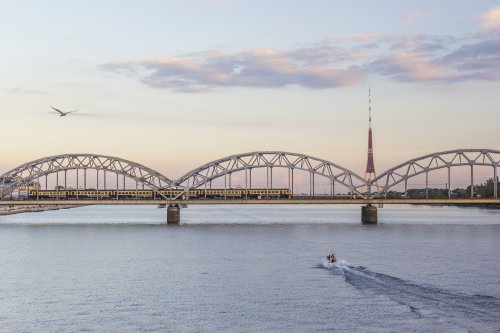
The intricate network of high-speed rail systems weaving across Europe stands as a testament to the continent’s commitment to efficient and interconnected transportation. These systems have revolutionized travel, offering a swift, comfortable, and convenient means of traversing national borders. Now, after decades of isolation, the Baltic nations are poised to integrate into this sophisticated European rail network, marking a significant step forward in regional connectivity. The keyword "Rail Baltica" is important here.
This year marks the commencement of construction on Rail Baltica, an ambitious undertaking that will physically link Estonia, Latvia, and Lithuania to the broader European rail infrastructure. This monumental project, estimated at $5.8 billion, is slated for completion in 2026. Spanning approximately 540 miles, the new railway will connect the capital cities of Tallinn, Riga, and Vilnius, extending south to Warsaw, Poland. From this crucial junction in Warsaw, passengers will gain seamless access to the vast network of trains reaching virtually every corner of Europe. The high-speed trains operating on the Rail Baltica line are projected to reach speeds of around 145 miles per hour, dramatically reducing travel times between key Baltic cities, in some cases cutting journey durations in half.
The genesis of Rail Baltica can be traced back to the late 1990s, with initial discussions and feasibility studies laying the groundwork for this transformative project. However, the recent geopolitical landscape, particularly the Russian invasion of Ukraine, served as a catalyst, injecting a renewed sense of urgency and purpose into the initiative. As Latvian Transport Minister Tālis Linkaits emphasized in August, "It is particularly important to ensure reliable connectivity with Western Europe and to fully use the new rail transport connection with Europe to increase our country’s defence capabilities." This statement underscores the strategic importance of Rail Baltica, not only for economic integration but also for bolstering security and resilience in the region.
The historical context of the Baltic states’ separation from the European rail system is rooted in the legacy of Soviet occupation. During the Soviet era, when the initial rail lines were constructed in the Baltic region, they were built to adhere to Russian gauge standards. These standards, characterized by a wider track gauge, are fundamentally incompatible with the narrower gauge used throughout the rest of Europe. This divergence in rail gauge created a significant barrier, effectively isolating the Baltic states from the European rail network.
Even after Estonia, Latvia, and Lithuania regained their independence in the early 1990s, the legacy of this incompatible rail infrastructure persisted. The Baltic nations remained heavily reliant on Russia for trade and transit, as the existing rail connections facilitated the movement of goods and people primarily eastward. The gauge incompatibility also presented a significant impediment to developing robust rail transport links with Western Europe. The necessity of transferring cargo and passengers between trains at border crossings resulted in delays, increased costs, and logistical complexities, hindering the development of seamless rail corridors.
The construction of Rail Baltica represents a decisive break from this historical pattern of isolation. By adopting the European standard gauge, the new railway will create a direct and uninterrupted connection to the European rail network, eliminating the need for time-consuming and costly gauge changes. This seamless integration will not only facilitate the movement of passengers but also streamline the transportation of goods, fostering greater economic integration and trade opportunities.
Beyond the practical benefits of enhanced connectivity and reduced travel times, Rail Baltica holds profound symbolic significance for the Baltic states. It represents a tangible manifestation of their commitment to European integration and their desire to strengthen ties with Western Europe. By physically linking themselves to the European rail network, the Baltic nations are reinforcing their political, economic, and cultural alignment with the broader European community.
The project is not without its challenges. The construction of a new railway line spanning hundreds of miles requires careful planning, coordination, and execution. Navigating environmental concerns, securing land rights, and managing the complex logistics of a large-scale infrastructure project all present significant hurdles. However, the unwavering commitment of the governments of Estonia, Latvia, and Lithuania, coupled with the support of the European Union, provides a strong foundation for overcoming these challenges and ensuring the successful completion of Rail Baltica.
The anticipated benefits of Rail Baltica extend far beyond the immediate region. The new railway will contribute to the development of a more sustainable and environmentally friendly transportation system in Europe. By offering a viable alternative to air and road travel, Rail Baltica will help to reduce carbon emissions and alleviate congestion on roads and in airports. Furthermore, the project will create new jobs and stimulate economic growth in the Baltic states and beyond.
The integration of the Baltic states into the European rail system represents a significant milestone in the ongoing process of European integration. It is a testament to the power of infrastructure to connect people, foster economic growth, and promote closer ties between nations. As the construction of Rail Baltica progresses, the anticipation is building for the day when passengers will be able to travel seamlessly by train from Tallinn to Warsaw and beyond, ushering in a new era of connectivity and opportunity for the Baltic region.
In just a few short years, the prospect of visiting the Baltic countries will be transformed. What was once a journey often requiring circuitous routes and multiple transfers will become a streamlined and efficient experience, thanks to the advent of Rail Baltica. The new railway will not only open up the Baltic states to more visitors but also facilitate greater cultural exchange, tourism, and business opportunities, further integrating the region into the heart of Europe.